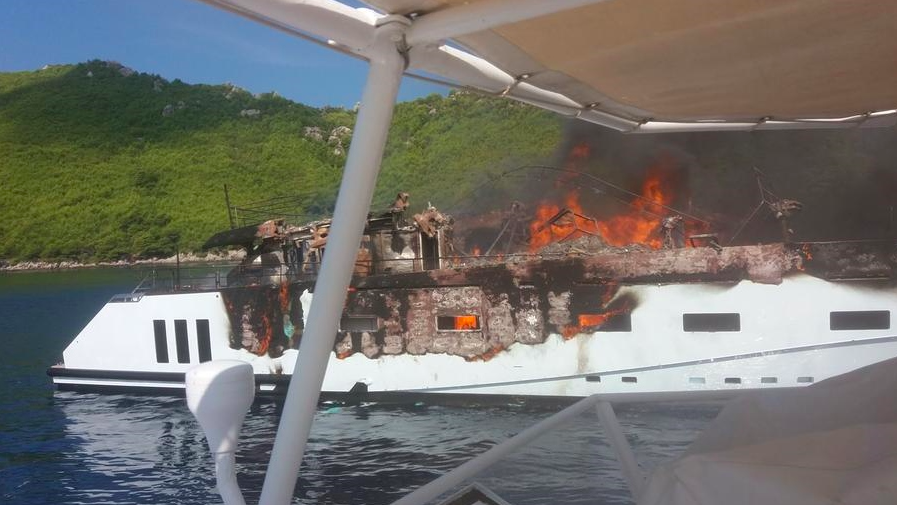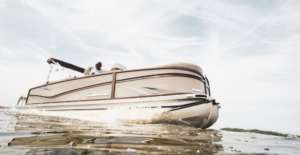Insurance refusals on lithium-ion boats

Edit: This article was edited to reflect the fact that a company name was used instead of a generic name for a toy (8June22). This article was not suggesting that the company named was responsible for the incident mentioned.
Lithium-ion batteries have been the cause of, and charged with, several notable marine fires in recent years. And now there’s talk of insurance companies refusing to cover boats. This is the time for boat owners to check their polices and speak to their insurance brokers, especially if they’re thinking of retrofitting lithium-ion powered engines.
The increased demand for slimmer, more compact and powerful electronic gadgets, and vehicles with higher ranges, means there is a greater need for batteries with higher storage capacity. Lithium-ion batteries are the most commonly used energy storage medium for consumer electronics and electric vehicles says Diabatix (makers of thermal engineering software).
As such, lithium-ion comes in many batteries, from those designed for electric vehicles (EV), to chargers for surfboards and other toys, and even mobile phones. And each of these has been blamed for devastating fires over the past few years.
Marine fires citing lithium-ion

Most recently, Felicity Ace sank after burning for almost two weeks in March 22. The abandoned cargo ship was transporting some 4,000 vehicles including Porsches, Audis, Lamborghinis and Bentleys.
On-scene reports indicated that the fire started in the ship’s cargo hold with a potential source cited as a lithium-ion battery from one of the electric vehicles.

The US National Transportation Safety Board investigation into the 75ft Conception, a dive boat, which caught fire and sank off the California coast in 2019, determined the fire began in a middle deck area where lithium-ion batteries were being charged.

And in 2018, MY Kanga caught fire while at anchor in the coastal area of Dubrovnik, Croatia. The safety investigation concluded that in all probability, the seat of the fire was the lithium-ion batteries which had been used with electric surfboards.
Insurance company pushback
With the push to electrify the marine industry, battery makers citing lithium-ion as the future, and the retrofitting of electric engines, the danger which lithium-ion batteries could pose is causing some insurance companies to pushback.
Internet comment boards across the marine industry carry stories of individuals being refused cover from high street names, and being asked to agree to clauses accepting 50 per cent of any loss due to misbehaviour of lithium-ion batteries. Other forum members have said that if an owners’ system was not upgraded and installed by an ABYC certified electrician, claims may be denied entirely.
“And this”, says Mike Wimbridge, MD Pantaenius UK, is a huge challenge for leisure marine where, “retrofitting is coming into a sector filled with huge numbers of people who like to do things themselves.”
“Some insurers will not accept a risk with lithium batteries and some are taking a pragmatic view,” says Malcolm Stewart, branch manager for A Plan. “The best thing to do is speak to your broker and let them know what you are doing.”
A future full of lithium-ion
Ben Craig, a technical specialist at the Maritime and Coastguard Agency (MCA), says the general consensus has shifted to the position that there is enough lithium to meet the exponential growth of electric propulsion, due to the growing exploitation of mineral deposits around the world. Furthermore, manufacturing experience is rapidly making lithium batteries cheaper.
But which boats, and which journeys, can be conducted under full electric propulsion is a nuanced question. Craig notes that while the target of a fast-charging electric vehicle with a 500km range and a dense network of charging points is a reasonable replacement for today’s cars, pushing a boat hull through water requires a lot of energy, and commercial journeys may cover up to thousands of kilometres across the open ocean.
“Here’s the conflict,” says Wimbridge. “The movement to alternative sources of power has most people engaged… but, at the same time, the move towards electrical power and other sources is in its prototype stage.” And it’s the prototypes, and watered-down copies of the prototypes, that can also cause the issues.
Superyacht vulnerabilities
The fire on MY Kanga occurred in September 2018.
The investigators said that the crew had been experiencing some problems with the batteries of the electric surfboards, with sea water leakage into three battery packs. The crew had noticed brownish-coloured water leaking from inside the batteries and had notified the manufacturers that they had intended to return them for repair/replacement.
“That boat would have been built to the highest standards,” says Wimbridge. “It was top end, professionally run, brand new, built to class, and was totally destroyed due to a battery on a toy.
“Large yachts are built to good standards. But owners want new jet surfboards or gizmos and the yacht becomes vulnerable to that. Plug-ins are not as robust as the yacht’s manufacturer’s own specification, and that opens-up vulnerabilities.
“People do buy batteries and chargers off brand,” he says, “human nature dictates that we often buy cheap, but we’ve all seen phone chargers blow-up.
“These mega yachts are vulnerable to charter guests coming on board and plugging something in and forgetting about it.”
“All the yachts are struggling,” says Simon Done, chief engineer on an 85m superyacht. “Everyone wants to bring on a flight board or this, that and the rest, but many yachts have just got old systems for putting out fires, like water and HyCC which just won’t do it for a thermal runaway.”
Thermal runaway science
Thermal runaway is an uncontainable exothermic reaction that can occur inside a lithium-ion battery when it is damaged or short-circuited, explains Diabatix.
Lithium-ion batteries have their cathode and anode separated by an extremely thin polyethylene barrier. If this polyethylene barrier is damaged, a short circuit occurs, which results in the materials inside the cell starting to decompose. These decomposition reactions are exothermic, which is why the battery temperature quickly rises to the melting point of the metallic lithium, causing a violent self-heating chain reaction.
During thermal runaway, the battery heats up to over 600°C in a matter of seconds. This results in the electrolytes inside the cells disintegrating into simpler, more flammable molecules, such as methane, ethane, and hydrogen gas. The cathode also starts to decompose and release oxygen. These gases result in pressure and temperature build up inside the battery, and eventually, an explosion.
As reported in MIN, firefighters on Felicity Ace, couldn’t use water, because traditional methods do not stop lithium-ion batteries from burning. They had to tackle the fire from the outside by cooling down the ship’s structure as it was too dangerous to go onboard.
CED Technologies warns subsequent reignition is possible due to lingering toxic, flammable vapours in the air. Fires that ignite from these highly condensed energy battery packs burn longer and stronger than non-electric car fires. They are much harder to extinguish, take more smothering agents to extinguish, and can potentially melt the entire metal frame of the car.
Done describes thermal runaway as ‘no joke’, saying fires caused by lithium-ion require specific management.
“A fire hose at full speed won’t even put it out,” he says. “But these fires can happen from charging a jet ski battery, or a flight board battery.”
Managing lithium-ion use
Done says these types of fires are preventable. Probes in each of the cells can monitor temperature and tell the charger it’s over a designate point which will shut down the charging.
“A lot of more modern systems have got this,” says Done, “but there are plenty of examples of boats which have had lithium-ion thermal runaway fires where they can’t put them out.”
But he believes that lithium-ion batteries can be managed.
“You manage it while you’re charging,” he says, “and then if you mess all that up, you manage it by having the correct storage area and then to extinguish it you need to have the correct fire extinguisher.”
The MCA’s catchily titled: Electrical Installations – Guidance for Safe Design, Installation and Operation of Lithium-ion Batteries, makes for sobering reading.
And while this is addressed to all shipowners, ship operators, masters and officers of ships, ship designers and shipbuilders it’s worth reading by any owner who’s considering a retrofit.
As well as setting out in detail the precautions that need to be taken around lithium-ion batteries, it says that although a battery system will contain many cascading levels of protective devices, the vessel should not employ operational procedures that rely on these protective devices for a safe condition.
As Done says: “In essence, good quality lithium batteries with internal temperature monitoring systems that cut off charging outside of operating ranges will be sufficient to prevent fires. So they can be used in a safe manner. The problem is not all lithium batteries have these monitors, so vigilance is the key, especially when on continuous charge (which should be avoided).”
Check insurance policies
One internet forum member rhetorically asks why some insurance companies are punishing lithium-ion usage, and says the answer is simple… insurance companies’ experience in boat failures has shown lithium-ion is causing insurance claims.
However, as Stewart says: “There is a lack of reliable information on lithium batteries on boats.”
Wimbridge agrees: “There’s not much data out there, but we know retrofitting electric batteries is difficult. There are lots of conversations around lithium. The assumption is that it’s the same for boating as to power – people share a battery between power tools. But owners must talk to their insurance company, as it’s not that simple. Where the insurance market is still unstable (storms in 2017, covid, Brexit, and Ukraine) their acceptance criteria might be easier to say ‘no’ to, than go through the hassle.
“And even if the insurance company says ‘yes’, it needs to be done professionally and signed off. Many insurer’s policies contain clauses that state that cover can be voided if clients retrofit a lithium engine without their knowledge/consent.
“You can never tell your insurers enough,” Wimbridge says. “If you’re thinking ‘should I, shouldn’t I’ mention this, the answer is always ‘yes’. You’re literally playing with fire.”
Neither of the lithium-ion battery manufacturers approached for comment responded.











Use AQAFORCE Batteries and drivetrains.
They got a insurance-approvel by Pantaenius.
This LOOKS like a typical insurance hype to increase the premiums for boat insurance.
NO mention or comparison is made with the significantly higher risks of fire from diesel fuel on vessels, which is an order or magnitude higher than lithium batteries.
No mention is made of existing standards that already address his issue, including UN standards.
NO mention is made risks ( what risks?() from batteries of mobile phones, among densest of lithium batteries…?
If MIN is going to raise a topic, can we at least have some informed comment please, not a few quotes, re-purposed images and general comments to suit a sponsoring Insurance provider..?
This article touches on 3 different topics 1) Conversion to electric propulsion. 2) Replacing the housebank on a diesel powered sailboat and 3) Carrying electric toys on board. These are very different situations.
This article fails to differentiate between lithium-ion and lithium iron phosphate technologies.
Imo this article causes more confusion instead of clarfying anything.
This is a terrible article. You draw no distinction between chemistries. LifePO4 chemistry is appropriate for domestic battery use on boats. Any other lithium chemistry is not. Lumping all these chemistries together and not differentiating between them is misleading and simply ignorant. How many lifePO4 battery fires have occured on boats? How many other lithium chemistry battery fires have occurred on boats? Make the distinction. The insurance industry is uneducated in the subject and simply lump all lithium batteries together. No wonder they are despised by the yachting consumer. Your article is badly researched and no help what’s so ever. There is move in liesure yachts to use prismatic lifePO4 battery technology. This bears no resemblance to the batteries used for motive power in electric surfboards or other superyacht toys.
This article mentions Fliteboards by name, suggesting there is a fire risk from our products. Yes Fliteboards are now one of the most popular toys to have on a yacht, and one of the reasons for this is the quality of our products. Fliteboard offer arguably the safest battery of its type in the market, with many battery safety features including phase change material to limit – or prevent thermal runaway. We have now shipped over 10,000 Fliteboard batteries and have never had a fire or other safety issue reported from one of our customers. I can’t speak for other marine toys, and all lithium battery products including mobile phones need to be treated carefully. However associating Fliteboard with fire issues is misleading and slanderous, and should be corrected. If you would like more information on our batteries and products please contact us rather than make assumptions.
Tim Evans’ comment is overwhelmingly correct.
This is an unfairly broad article with very little knowledge behind it when it comes to what is actually being discussed and what boaters are actually considering.
These fires stem from poor, damaged or cheap lithium cobalt, lithium polymer or lithium titanate batteries, none of which any sensible boat-owner would be considering for a house system in the first place.
These fires stem from (in exception of the cargo ship fire, but there is literally zero evidence to imply that the cargo ship fire was caused by lithium batteries failing – but they definitely contributed to the fire once the fire had grown) low value consumer electronic toy batteries that were mistreated, cheap or damaged and which suffered from a thermal-runaway. No boat owner is considering this for their house system. Boat owners are, however, considering Lithium Iron Phosphate batteries for installation as they last far longer than lead acid batteries, are far lighter, and give deeper and superior performance values.
Writing this piece inevitably damages the movement away from outdated lead acid batteries either because understanding of lithium is not deep enough, or because an insurance company can benefit from this lack of understanding.
This is just totally misleading and WRONG:
Felicity Ace Cargo Ship – There was zero evidence that it was caused by electric cars, only that there was a mix of petrol and electric cars being carried, certainly once it was burning the batteries burnt as well, but so was the petrol in all the GAS cars.
Conception Dive Boat – Possibly caused by batteries being charged (likely to be dive torch batteries I’d suggest)
MY Kanga – Electric surfboards cited as possible cause
So, from ALL the examples in this story, the fires are possibly caused from portable Lithium battery devices. These are NOT the safer Lithium Iron Phosphate (LiFePO4) batteries that are now being installed as an AGM replacement. Your mobile phone is more at risk of creating a fire than a house battery bank of LiFePO4, but I never see any reports about banning mobile phones off of your boat.
In reading this article, risk assessments, and advisories, each sites the monitoring of temperature as being a key factor in prevention of thermal runaway leading to fire but a monitoring systems used during the prevention phase to detect the initial “off-gas” event of electrolyte solvent vapors may prevent thermal runaway 5-15 minutes prior to battery cell temperature increase. The initial detection of the off-gas provides an opportunity to avoid thermal runaway alert the BMS to the presence of that off-gas so that power can be isolated, and HVAC increased to drop temp. Traditional H2, CO, or LEL PPM detectors function too late after thermal runaway to provide any adequate warning time. And certainly pointing a thermal camera at a wide area is not an answer either. Active PPM per second off-gas monitoring systems are available but Insurance companies and Flag/Class may have to temporarily accept products that are not currently certified for marine usage.
This article is so wrong. The author obviously wrote this before he even realised there was a difference between lithium ion batteries ( phones, toys, laptops etc) and lithium phosphate batteries typically used in boat house banks. Really annoying that I had to argue to an insurance company about the difference. They don’t understand either. Morons.
That is why we – at Galvani boats – only use LiFePO4 technology. These ‘lithium iron phosphate’ batteries are chemically much more stable compared to Lithium-ion and non-combustible. See: https://www.galvaniboats.nl/en/our-batteries.